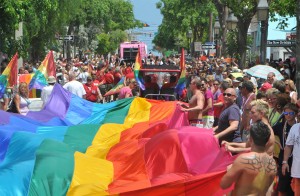LET ME SEE YOUR TRUE COLOURS

By Alex Wiggan
You know, Dorothy might have been onto something when she sang about going over the rainbow in the Wizard of Oz (1939), because with all those pretty colours in one place, the pint-sized tyke must have known there was more to that piece of meteorological phenomena than first appeared. Dorothy believed that the rainbow represented an escape route to a place of her dreams; a place where she could be free of the drudgery of daily life. Ok, so this same kid also spent an unhealthy amount of time alone amongst the cornfields, but is it any wonder that with the rainbow representing happiness, the gay community quickly noticed Dorothy’s particular stance on combined colours? Yep, with just six different stripes, the homosexually inclined quickly turned the rainbow into something that became the ultimate gateway to a happier existence. Some may know it as the Rainbow Flag others call it the Pride Flag, but whatever your own personal preference the flag is a very important bit of material that is more than just a name. Rainbow flags have been around for years, but they were made extremely popular in 1978 thanks to the work of San Francisco artist Gilbert Baker. Since then the colours of the flags have become synonymous with gay life and there’s not a summer that goes by where the flag isn’t seen at a Pride event being brandished like a bit of sexually orientated semaphore. Oh it might not be so easily noticeable during the rest of the year, but look hard enough and you’ll see it cropping up on badges, outside bars and during the summer months it’ll be wrapped around the crotches of scantily clad twinks. Admittedly the mixture of colours might clash with that new frilly top you bought from Vivienne Westwood/Primani, but have you ever really stopped to think what it’s all about? Have you ever considered that there might be more to the flag than just some random combination of colours?
The flag is made up of red, orange, yellow, green, blue and purple and is said to represent life, healing, sunlight, nature, harmony and spirit, respectively. Hmm, sounds like a New Age painting chart from B & Q, doesn’t it? Well it might, but hold up there homoboy and keep on following these words, because that’s one courageous collage of colours on that there flag and so it’s time you got hip to the beat. Instead of what you’re told, why not take the colours and think about other associations that they could represent; then maybe you’ll reconsider your way of thinking. Let’s say red represents passion, orange a citrus food, yellow is happiness, green jealousy, blue depression and purple is royalty. Now that sounds about right, doesn’t it? No? So you’re saying that you’re not a sex-starved fruit, who is equal parts cheery, jealous and depressed, whilst also a bit of a queen? Oh come on, that sums up the average emotional range of most boys! The Pride Flag is representative of all of these aspects; it’s like multiculturalism and multicoloured..ism and perhaps anything else that you can add ism to the end of, all wrapped up in one bit of cloth. It’s not just a flag it’s a brave banner, valiantly bringing homosexual ways to the masses!
